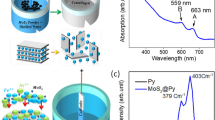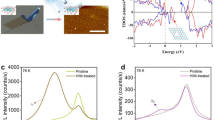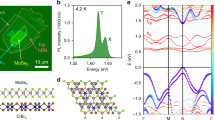Abstract
In the past few years, the effect of strain on the optical and electronic properties of MoS2 layers has attracted particular attention as it can improve the performance of optoelectronic and spintronic devices. Although several approaches have been explored, strain is typically externally applied on the two-dimensional material. In this work, we describe the preparation of a reversible ‘self-strainable’ system in which the strain is generated at the molecular level by one component of a MoS2-based composite material. Spin-crossover nanoparticles were covalently grafted onto functionalized layers of semiconducting MoS2 to form a hybrid heterostructure. Their ability to switch between two spin states on applying an external stimulus (light irradiation or temperature change) serves to generate strain over the MoS2 layer. A volume change accompanies this spin crossover, and the created strain induces a substantial and reversible change of the electrical and optical properties of the heterostructure.

This is a preview of subscription content, access via your institution
Access options
Access Nature and 54 other Nature Portfolio journals
Get Nature+, our best-value online-access subscription
$29.99 / 30 days
cancel any time
Subscribe to this journal
Receive 12 print issues and online access
$259.00 per year
only $21.58 per issue
Buy this article
- Purchase on Springer Link
- Instant access to full article PDF
Prices may be subject to local taxes which are calculated during checkout





Similar content being viewed by others
Data availability
The data that support the findings of this study are available within the paper and its Supplementary Information files and from the corresponding authors upon request. Source data are provided with this paper.
References
Stanford, M. G., Rack, P. D. & Jariwala, D. Emerging nanofabrication and quantum confinement techniques for 2D materials beyond graphene. npj 2D Mater. Appl. 2, 20 (2018).
Wang, L. et al. One-dimensional electrical contact to a two-dimensional material. Science 342, 614–617 (2013).
Xia, W. et al. Recent progress in van der Waals heterojunctions. Nanoscale 9, 4324–4365 (2017).
Onga, M. et al. Antiferromagnet–semiconductor van der Waals heterostructures: interlayer interplay of exciton with magnetic ordering. Nano Lett. 20, 4625–4630 (2020).
Hirsch, A. & Hauke, F. Post-graphene 2D chemistry: the emerging field of molybdenum disulfide and black phosphorus functionalization. Angew. Chem. Int. Ed. 57, 4338–4354 (2018).
López-Cabrelles, J. et al. Isoreticular two-dimensional magnetic coordination polymers prepared through pre-synthetic ligand functionalization. Nat. Chem. 10, 1001–1007 (2018).
Rodríguez-San-Miguel, D., Montoro, C. & Zamora, F. Covalent organic framework nanosheets: preparation, properties and applications. Chem. Soc. Rev. 49, 2291–2302 (2020).
Zhao, Y., Bertolazzi, S. & Samorì, P. A universal approach toward light-responsive two-dimensional electronics: chemically tailored hybrid van der Waals heterostructures. ACS Nano 13, 4814–4825 (2019).
Jariwala, D., Marks, T. J. & Hersam, M. C. Mixed-dimensional van der Waals heterostructures. Nat. Mater. 16, 170–181 (2017).
Choi, J., Zhang, H. & Choi, J. H. Modulating optoelectronic properties of two-dimensional transition metal dichalcogenide semiconductors by photoinduced charge transfer. ACS Nano 10, 1671–1680 (2016).
Das, S., Robinson, J. A., Dubey, M., Terrones, H. & Terrones, M. Beyond graphene: progress in novel two-dimensional materials and van der Waals solids. Ann. Rev. Mater. Res. 45, 1–27 (2015).
Manzeli, S., Ovchinnikov, D., Pasquier, D., Yazyev, O. V. & Kis, A. 2D transition metal dichalcogenides. Nat. Rev. Mater. 2, 17033 (2017).
Hu, Z. et al. Two-dimensional transition metal dichalcogenides: interface and defect engineering. Chem. Soc. Rev. 47, 3100–3128 (2018).
Ganatra, R. & Zhang, Q. Few-layer MoS2: a promising layered semiconductor. ACS Nano 8, 4074–4099 (2014).
Kan, M. et al. Structures and phase transition of a MoS2 monolayer. J. Phys. Chem. C 118, 1515–1522 (2014).
Wang, L., Xu, Z., Wang, W. & Bai, X. Atomic mechanism of dynamic electrochemical lithiation processes of MoS2 nanosheets. J. Am. Chem. Soc. 136, 6693–6697 (2014).
Yuwen, L. et al. Rapid preparation of single-layer transition metal dichalcogenide nanosheets via ultrasonication enhanced lithium intercalation. Chem. Commun. 52, 529–532 (2015).
Lin, Y.-C., Dumcenco, D. O., Huang, Y.-S. & Suenaga, K. Atomic mechanism of the semiconducting-to-metallic phase transition in single-layered MoS2. Nat. Nanotechnol. 9, 391–396 (2014).
Eda, G. et al. Photoluminescence from chemically exfoliated MoS2. Nano Lett. 11, 5111–5116 (2011).
Fan, X. et al. Fast and efficient preparation of exfoliated 2H MoS2 nanosheets by sonication-assisted lithium intercalation and infrared laser-induced 1 T to 2H phase reversion. Nano Lett. 15, 5956–5960 (2015).
Yang, D., Sandoval, S. J., Divigalpitiya, W. M. R., Irwin, J. C. & Frindt, R. F. Structure of single-molecular-layer MoS2. Phys. Rev. B 43, 12053–12056 (1991).
Yun, W. S., Han, S. W., Hong, S. C., Kim, I. G. & Lee, J. D. Thickness and strain effects on electronic structures of transition metal dichalcogenides: 2H-MX2 semiconductors (M = Mo, W; X = S, Se, Te). Phys. Rev. B 85, 033305 (2012).
Ouyang, B., Xiong, S., Yang, Z., Jing, Y. & Wang, Y. MoS2 heterostructure with tunable phase stability: strain induced interlayer covalent bond formation. Nanoscale 9, 8126–8132 (2017).
Conley, H. J. et al. Bandgap engineering of strained monolayer and bilayer MoS2. Nano Lett. 13, 3626–3630 (2013).
Manzeli, S., Allain, A., Ghadimi, A. & Kis, A. Piezoresistivity and strain-induced band gap tuning in atomically thin MoS2. Nano Lett. 15, 5330–5335 (2015).
Sun, Y. & Liu, K. Strain engineering in functional 2-dimensional materials. J. Appl. Phys. 125, 082402–082412 (2019).
Yang, R. et al. Tuning optical signatures of single- and few-layer MoS2 by blown-bubble bulge straining up to fracture. Nano Lett. 17, 4568–4575 (2017).
Castellanos-Gomez, A. et al. Local strain engineering in atomically thin MoS2. Nano Lett. 13, 5361–5366 (2013).
Tsai, M.-Y. et al. Flexible MoS2 field-effect transistors for gate-tunable piezoresistive strain sensors. ACS Appl. Mater. Interfaces 7, 12850–12855 (2015).
Biccai, S. et al. Negative gauge factor piezoresistive composites based on polymers filled with MoS2 nanosheets. ACS Nano 13, 6845–6855 (2019).
Urakawa, A. et al. Combined, modulation enhanced X-ray powder diffraction and Raman spectroscopic study of structural transitions in the spin crossover material [Fe(Htrz)2(trz)](BF4). J. Phys. Chem. C 115, 1323–1329 (2011).
Gütlich, P. & Goodwin, H. A. Spin Crossover in Transition Metal Compounds I (Springer, 2009)..
Grosjean, A. et al. Crystal structures and spin crossover in the polymeric material [Fe(Htrz)2(trz)](BF4) including coherent-domain size reduction effects. Eur. J. Inorg. Chem. 2013, 796–802 (2013).
Dugay, J. et al. Sensing of the molecular spin in spin-crossover nanoparticles with micromechanical resonators. J. Phys. Chem. C 123, 6778–6786 (2019).
Coronado, E., Galán-Mascarós, J. R., Monrabal-Capilla, M., García-Martínez, J. & Pardo-Ibáñez, P. Bistable spin-crossover nanoparticles showing magnetic thermal hysteresis near room temperature. Adv. Mater. 19, 1359–1361 (2007).
Rotaru, A. et al. Spin state dependence of electrical conductivity of spin crossover materials. Chem. Commun. 48, 4163–4165 (2012).
Boldog, I. et al. Spin-crossover nanocrystals with magnetic, optical, and structural bistability near room temperature. Angew. Chem. Int. Ed. 47, 6433–6437 (2008).
Shepherd, H. J. et al. Molecular actuators driven by cooperative spin-state switching. Nat. Commun. 4, 2607 (2013).
Koo, Y.-S. & Galán-Mascarós, J. R. Spin crossover probes confer multistability to organic conducting polymers. Adv. Mater. 26, 6785–6789 (2014).
Chen, Y.-C., Meng, Y., Ni, Z.-P. & Tong, M.-L. Synergistic electrical bistability in a conductive spin crossover heterostructure. J. Mater. Chem. C 3, 945–949 (2015).
Rat, S. et al. Coupling mechanical and electrical properties in spin crossover polymer composites. Adv. Mater. 30, 1705275 (2018).
Dugay, J. et al. Phase transitions in spin-crossover thin films probed by graphene transport measurements. Nano Lett. 17, 186–193 (2017).
Geest, E. P. et al. Contactless spin switch sensing by chemo‐electric gating of graphene. Adv. Mater. 32, 1903575–1903579 (2020).
Konstantinov, N. et al. Electrical read-out of light-induced spin transition in thin film spin crossover/graphene heterostructures. J. Mater. Chem. C 9, 2712–2720 (2021).
Titos-Padilla, S., Herrera, J. M., Chen, X.-W., Delgado, J. J. & Colacio, E. Bifunctional hybrid SiO2 nanoparticles showing synergy between core spin crossover and shell luminescence properties. Angew. Chem. Int. Ed. 50, 3290–3293 (2011).
Herrera, J. M. et al. Studies on bifunctional Fe(II)-triazole spin crossover nanoparticles: time-dependent luminescence, surface grafting and the effect of a silica shell and hydrostatic pressure on the magnetic properties. J. Mater. Chem. C 3, 7819–7829 (2015).
Giménez-Marqués, M., García-Sanz de Larrea, M. L. & Coronado, E. Unravelling the chemical design of spin-crossover nanoparticles based on iron(II)-triazole coordination polymers: towards a control of the spin transition. J. Mater. Chem. C 3, 7946–7953 (2015).
Torres-Cavanillas, R. et al. Downsizing of robust Fe-triazole@SiO2 spin-crossover nanoparticles with ultrathin shells. Dalton Trans. 48, 15465–15469 (2019).
Ulman, A. Formation and structure of self-assembled monolayers. Chem. Rev. 96, 1533–1554 (1996).
Joensen, P., Frindt, R. F. & Morrison, S. R. Single-layer MoS2. Mat. Res. Bull. 21, 457–461 (1986).
Leng, K. et al. Phase restructuring in transition metal dichalcogenides for highly stable energy storage. ACS Nano 10, 9208–9215 (2016).
Morant-Giner, M. et al. Prussian Blue@MoS2 layer composites as highly efficient cathodes for sodium- and potassium-ion batteries. Adv. Funct. Mater. 28, 1706125 (2017).
Voiry, D. et al. Covalent functionalization of monolayered transition metal dichalcogenides by phase engineering. Nat. Chem. 7, 45–49 (2015).
Saito, R., Tatsumi, Y., Huang, S., Ling, X. & Dresselhaus, M. S. Raman spectroscopy of transition metal dichalcogenides. J. Phys. Condens. Matter 28, 353002 (2016).
Pramoda, K. et al. Nanocomposites of C3N4 with layers of MoS2 and nitrogenated RGO, obtained by covalent cross-linking: synthesis, characterization, and HER activity. ACS Appl. Mater. Interfaces 9, 10664–10672 (2017).
Pramoda, K., Gupta, U., Ahmad, I., Kumar, R. & Rao, C. N. R. Assemblies of covalently cross-linked nanosheets of MoS2 and of MoS2-RGO: synthesis and novel properties. J. Mater. Chem. A 4, 8989–8994 (2016).
Dugay, J. et al. Spin switching in electronic devices based on 2D assemblies of spin-crossover nanoparticles. Adv. Mater. 27, 1288–1293 (2015).
Dugay, J. et al. Charge mobility and dynamics in spin-crossover nanoparticles studied by time-resolved microwave conductivity. J. Phys. Chem. Lett. 9, 5672–5678 (2018).
Rotaru, A. et al. Nano-electromanipulation of spin crossover nanorods: towards switchable nanoelectronic devices. Adv. Mater. 25, 1745–1749 (2013).
Molnár, G., Rat, S., Salmon, L., Nicolazzi, W. & Bousseksou, A. Spin crossover nanomaterials: from fundamental concepts to devices. Adv. Mater. 30, 17003862 (2018).
Roldán, R., Castellanos-Gomez, A., Cappelluti, E. & Guinea, F. Strain engineering in semiconducting two-dimensional crystals. J. Phys. Condens. Matter 27, 313201 (2015).
Splendiani, A. et al. Emerging photoluminescence in monolayer MoS2. Nano Lett. 10, 1271–1275 (2010).
McCreary, K. M., Hanbicki, A. T., Sivaram, S. V. & Jonker, B. T. A- and B-exciton photoluminescence intensity ratio as a measure of sample quality for transition metal dichalcogenide monolayers. APL Mater. 6, 111106 (2018).
Pető, J. et al. Moderate strain induced indirect bandgap and conduction electrons in MoS2 single layers. npj 2D Mater. Appl. 3, 39 (2019).
Guillaume, F. et al. Photoswitching of the spin crossover polymeric material [Fe(Htrz)2(trz)](BF4) under continuous laser irradiation in a Raman scattering experiment. Chem. Phys. Lett. 604, 105–109 (2014).
Korn, T., Heydrich, S., Hirmer, M., Schmutzler, J. & Schüller, C. Low-temperature photocarrier dynamics in monolayer MoS2. Appl. Phys. Lett. 99, 102109 (2011).
Lefter, C. et al. Dielectric and charge transport properties of the spin crossover complex [Fe(Htrz)2(trz)](BF4). Phys. Status Solidi RRL 8, 191–193 (2013).
Chaves, A. et al. Bandgap engineering of two-dimensional semiconductor materials. npj 2D Mater. Appl. 4, 29 (2020).
Hui, Y. Y. et al. Exceptional tunability of band energy in a compressively strained trilayer MoS2 sheet. ACS Nano 7, 7126–7131 (2013).
Gant, P. et al. A strain tunable single-layer MoS2 photodetector. Mater. Today 27, 8–13 (2019).
Prins, F., Monrabal-Capilla, M., Osorio, E. A., Coronado, E. & Van Der Zant, H. S. J. Room-temperature electrical addressing of a bistable spin-crossover molecular system. Adv. Mater. 23, 1545–1549 (2011).
Torres-Cavanillas, R. et al. Design of bistable gold@spin-crossover core–shell nanoparticles showing large electrical responses for the spin switching. Adv. Mater. 31, 1900039 (2019).
Holovchenko, A. et al. Near room-temperature memory devices based on hybrid spin-crossover@SiO2 nanoparticles coupled to single-layer graphene nanoelectrodes. Adv. Mater. 28, 7228–7233 (2016).
Coronado, E. Molecular magnetism: from chemical design to spin control in molecules, materials and devices. Nat. Rev. Mater. 5, 87–104 (2020).
Acknowledgements
We acknowledge the financial support from the EU (ERC-Advanced Grant 78822-MOL-2D and FET-OPEN COSMICS 766726), the Spanish MICINN (PID2020-117152RB-I00, PID2020-117264GB-I00, Excellence Unit María de Maeztu CEX2019-000919-M, RTI2018-098568-A-I00 to S.T. and EQC2018-004888-P, co-financed by FEDER) and the Generalitat Valenciana (Prometeo Program of Excellence: PROMETEO/2017/066, PO FEDER Program IDIFEDER/2018/061 and IDIFEDER/2020/063 and the GentT Program CIDEGENT/2018/005 to J.C.-F. and SEJI/2020/036 to M.G.-M.). M.M.-G. thanks the Spanish MECD for the award of a FPU Grant. The Spanish MICINN is also acknowledged for a predoctoral fellowship (to R.T.-C.), two Juan de la Cierva Incorporación postdoctoral Grants (IJCI-2016-27441 to S.C.-S. and IJCI-2017-33538 to M.G.) and two Ramón y Cajal Contracts (RYC-2016-19817 to S.T. and RYC2019-027902-I to M.G.-M.). M.G.-M. thanks ‘la Caixa’ Foundation for support (LCF/BQ/PI19/11690022). The authors are grateful to J. M. Herrera from the Department of Inorganic Chemistry (Universidad de Granada) for his helpful discussion on the core–shell SCO nanoparticles.
Author information
Authors and Affiliations
Contributions
R.T.-C. and M.M.-G. contributed equally to this work. R.T.-C. was responsible for the design, synthesis and characterization of the new heterostructure and was involved in all the experimental measurements, the discussion and the preparation of the manuscript. M.M.-G. was in charge of the preparation of the exfoliated material and helped with all the characterization steps of the new system. M.G. was in charge of all the transport characterizations, in which G.E.-A., J.D. and S.T. were involved. S.C.-S. helped with the discussion and theoretical interpretation of the observed properties. M.G.-M. contributed to the SCO-NPs preparation and the discussion and interpretation of the results. J.C.-F. was involved in the PL experiments and their interpretation. A.F.-A. designed the work and was involved in the development and coordination of all the experimental parts, discussion of the results and preparation of the manuscript. E.C. supervised all the work and the preparation of the manuscript. All the authors revised and contributed to the presented manuscript.
Corresponding authors
Ethics declarations
Competing interests
The authors declare no competing interests.
Additional information
Peer review information Nature Chemistry thanks Birgit Weber and the other, anonymous, reviewer(s) for their contribution to the peer review of this work.
Publisher’s note Springer Nature remains neutral with regard to jurisdictional claims in published maps and institutional affiliations.
Extended data
Extended Data Fig. 1 Magnetic characterization of the composites.
a,b, Thermal variation of the χMT product for the SCO/MoS2-1 (a) and SCO/MoS2-2a (b). In both cases, the χMT value increases at the transition temperature from LS to HS, ulteriorly recovering its initial value with the reverse transition supporting the integrity of the SCO-NPs in the composites. χM, molar magnetic susceptibility.
Extended Data Fig. 2 Temperature-dependent photoluminescence of the composites.
a-d, Evolution of the PL emission maximum with the temperature of SCO/MoS2-1 (left panels) and SCO/MoS2-2a (right panels) during the heating (a,b) and the cooling (c,d) processes. The excitation power was fixed at 0.08 mW/µm2 to avoid thermal interferences. At any temperature between spin transition temperatures (380-340 K), the A peak position depends on the SCO-NPs spin state for both samples (that is, on the heating or cooling process), shifting to lower values in the HS (cooling process). This effect is observed to be more substantial for SCO/MoS2-1.
Extended Data Fig. 3 SCO/MoS2-2 optical response.
a, PL spectra of SCO/MoS2-2a at LS (red line, heating), and HS states (blue line, cooling), taken at 373 K and 0.08 mW. Clearly the HS state displays an A peak located at lower energy due to the strain applied by the SCO-NPs with increased volume after spin transition. b, PL shift as a function of the temperature (red dots, heating and blue dots, cooling). The position of the A peak of the MoS2 reflects the hysteretical behaviour of the SCO-NPs spin transition. Error bars represent the standard deviation calculated from at least three different areas measured at each temperature.
Extended Data Fig. 4 Temperature-dependent Raman spectra of the SCO-NPs.
a,b, Raman spectra of the SCO-NPs at different temperatures during the heating (a) and cooling (b) processes. The Raman spectra change depending on the SCO-NPs spin state.
Extended Data Fig. 5 Temperature-dependent photoluminescence of the CE-MoS2(2H).
a,b, Evolution of the PL emission maximum with the temperature of phase converted CE-MoS2(2H) during the heating (a) and the cooling (b) processes. c, PL maximum shifts as a function of temperature (red dots, heating and blue dots, cooling).The position of the PL maximum exhibits a linear displacement with the temperature. Processed error bars represent standard deviation calculated from at least three different areas measured at each temperature. Excitation power at 0.08 mW/µm2.
Extended Data Fig. 6 Raman spectra of the SCO-NPs upon light irradiation.
SCO-NPs Raman spectra at different conditions. a, Temperature: 363 K and laser intensity 0.08 mW (inside SCO-NPs hysteresis between spin transition temperatures), during the heating (LS, purple) and the cooling (HS, yellow) processes. b, At room temperature with two different laser intensities: 0.08 mW (purple) and 0.8 mW (yellow), exhibiting the typical spectrum of the LS and HS states, respectively.
Supplementary information
Supplementary Information
Supplementary Figs. 1–15, Discussion and Tables 1–7.
Supplementary Video 1
Volume modulation as a function of the temperature of the spin-crossover core-shell nanoparticles (core: [Fe(Htrz)2(trz)](BF4); shell: SiO2).
Supplementary Data
Source measured data for histograms.
Source data
Source Data Fig. 5b
Source measured data for statistical analysis.
Source Data Extended Data Fig. 3b
Source measured data for statistical analysis.
Source Data Extended Data Fig. 5c
Source measured data for statistical analysis.
Rights and permissions
About this article
Cite this article
Torres-Cavanillas, R., Morant-Giner, M., Escorcia-Ariza, G. et al. Spin-crossover nanoparticles anchored on MoS2 layers for heterostructures with tunable strain driven by thermal or light-induced spin switching. Nat. Chem. 13, 1101–1109 (2021). https://doi.org/10.1038/s41557-021-00795-y
Received:
Accepted:
Published:
Issue Date:
DOI: https://doi.org/10.1038/s41557-021-00795-y
This article is cited by
-
Thickness-dependent spin bistable transitions in single-crystalline molecular 2D material
npj 2D Materials and Applications (2022)



